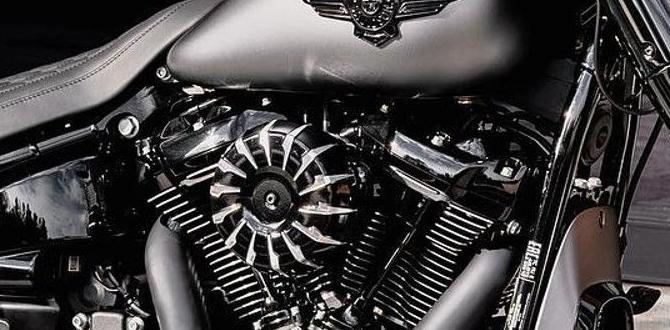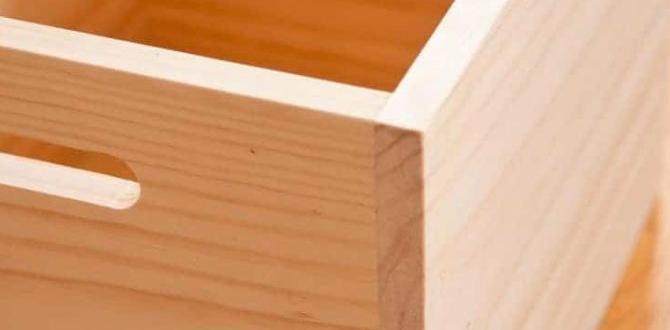Finish Nailer for Woodworking Projects: Your Ultimate Guide to Achieving Flawless DIY Results! Learn which finish nailer is best, how to use it safely, and common mistakes to avoid for beautiful, professional-looking projects.
Hey there, fellow DIYer! Ever look at those beautiful woodworking projects with perfectly flush trim or intricate cabinetry and wonder how they did it? You might think it’s all about fancy tools and years of experience. While experience helps, one tool can make a huge difference right away: the finish nailer.
Sometimes, hammering nails by hand can be slow, frustrating, and lead to bent nails and dinged wood. That’s where a finish nailer comes in! It’s like a magic wand for making woodworking projects much easier and your results much cleaner.
But with different types out there, how do you pick the right one? And how do you use it safely and effectively? Don’t worry, I’ve got your back. This guide will walk you through everything you need to know about finish nailers for woodworking, making your next project a breeze!
Table of Contents
Why a Finish Nailer is a Woodworker’s Best Friend
For any woodworking project that involves assembling parts, attaching trim, or building cabinets, a finish nailer can be an absolute game-changer. It drives thin, slender nails with precision and speed, minimizing surface damage and making your work look incredibly professional.
Think about those times you’ve struggled to get a nail perfectly straight, or when your hammer slips and dents the wood. A finish nailer eliminates much of that frustration. It’s designed to be quick, efficient, and leave a clean, almost invisible mark.
Whether you’re a seasoned pro or just starting out, incorporating a finish nailer into your toolkit can significantly improve the quality and speed of almost any project. It truly is an essential tool for anyone serious about woodworking.
Understanding the Different Types of Finish Nailers
Before you dive into buying one, it’s helpful to know the main types of finish nailers available. Each has its own pros and cons, and understanding these will help you choose the best fit for your needs and budget.
Pneumatic Finish Nailers
These are the classic workhorses. Pneumatic nailers run on compressed air from an air compressor. They are generally powerful, reliable, and lightweight in your hand because the motor is in the compressor, not the tool itself.
Pros:
- Powerful and consistent drives.
- Durable and long-lasting.
- Generally more affordable than cordless options.
- Lighter weight in hand.
Cons:
- Requires an air compressor and air hose, which adds to the setup and takedown time.
- The hose can be a tripping hazard or get in the way.
- Compressor noise can be considerable.
Cordless/Battery-Powered Finish Nailers
These nailers have their own built-in power source, usually a rechargeable battery, and sometimes they also use a small fuel cell. They offer the ultimate in portability and convenience.
Pros:
- No hoses or compressors needed – completely portable.
- Quick setup and cleanup.
- Great for working in remote locations or where power is limited.
Cons:
- Can be heavier due to the battery and motor.
- Generally more expensive upfront.
- Battery life can be a limitation for long jobs.
- Nail depth consistency can sometimes be an issue compared to pneumatics.
Electric (Corded) Finish Nailers
These nailers plug directly into a wall outlet. They are a good intermediate option if you like the idea of no compressor but don’t want to invest in batteries yet.
Pros:
- No fuel cells or batteries to worry about.
- Generally less expensive than cordless models.
- Consistent power as long as it’s plugged in.
Cons:
- Tethered to a power outlet by a cord, limiting mobility and creating a potential hazard.
- Can be heavier than pneumatic nailers.
- Less powerful than many pneumatic options.
Choosing the Right Gauge: A Crucial Decision
Finish nailers use different “gauges” of nails, which refers to the diameter of the nail. This is super important because it affects the holding power and the visibility of the nail head after it’s driven.
Common gauges for woodworking include:
- 18-Gauge (Brad Nailer): These are the slimmest. They drive very thin nails with small heads, making them almost invisible. Perfect for delicate trim, mouldings, and any project where you want a clean finish with minimal filling. They don’t offer a lot of structural holding power.
- 16-Gauge (Finish Nailer): These nails are a bit thicker than 18-gauge, offering more holding power while still leaving a relatively small, easy-to-hide nail head. They are excellent for attaching baseboards, crown molding, and assembling furniture where a bit more strength is needed than an 18-gauge offers.
- 15-Gauge (Finner Nailer): These are even thicker than 16-gauge and leave a slightly larger, but still concealable, head. They offer good holding power and are great for attaching heavier trim, door frames, and other applications where a stronger hold is beneficial.
For general woodworking projects, especially for trim and cabinetry newcomers, the 16-gauge finish nailer is often the most versatile and recommended starting point. It strikes a great balance between holding power and finish quality.
Essential Features to Look For
When you’re shopping, keep an eye out for these features that can make your life much easier:
- Adjustable Depth Control: This lets you set how deep the nail is driven into the wood. You want nails to be flush or slightly countersunk, not sticking out or buried too deep.
- Tool-Free Jam Release: Jams happen! A tool-free release means you can clear a jammed nail quickly without needing extra tools.
- Nail Thickness Compatibility: Make sure the nailer accepts the gauge and length of nails you intend to use most often.
- No-Mar Tip: A soft rubber tip on the nose prevents accidental marring or denting of your wood surface, which is crucial for finished projects.
- Swiveling Belt Hook: Handy for keeping the nailer close at hand but out of the way when you’re not actively using it.
- Air Connector (for Pneumatic): Look for a standard fitting, usually 1/4-inch NPT, which is common for most air hoses.
- Battery Compatibility (for Cordless): If you already own tools from a particular brand, sticking with their battery system can save you money.
How to Use Your Finish Nailer Safely
Safety is paramount with any power tool, and a finish nailer is no exception. Understanding and following these safety guidelines will help you avoid injury and protect your work.
- Always Wear Safety Glasses: This is non-negotiable. Flying nails, wood splinters, or debris can cause serious eye injury.
- Read the Manual: Every nailer is slightly different. Familiarize yourself with your specific tool’s operation and safety features.
- Ensure the Nailer is Set to Sequential Trip Mode: Most finish nailers have two firing modes:
- Sequential Trip (Safe Mode): You must press the safety contact tip against the wood before squeezing the trigger to fire a nail. This prevents accidental firing.
- Contact Trip (Rapid Fire Mode): Squeeze the trigger, then tap the safety contact tip against the wood to fire. This is faster but riskier if not used properly. For most beginners, sticking to sequential trip is highly recommended. You can learn to activate it safely by pressing the tip firmly first before engaging the trigger.
- Never Point the Nailer at Yourself or Others: Treat it like a loaded firearm – always assume it can fire.
- Keep Fingers Away from the Nose: Don’t rest your finger on the trigger or near the tip when the tool is armed.
- Work on a Stable Surface: Ensure your workpiece is secure and won’t move unexpectedly.
- Disconnect Power When Not in Use, Clearing Jams, or Changing Nails: For pneumatic tools, disconnect the air hose. For cordless, remove the battery. For corded, unplug it.
- Be Aware of the Nailer’s Kickback: Like any tool that fires a projectile, there can be a slight recoil. Brace yourself appropriately.
- Check for Hidden Obstacles: Before firing into a piece of wood, be aware of what might be behind it, like electrical wires or plumbing.
- Let the Tool Do the Work: Don’t force the nailer against the wood. Apply firm but even pressure.
Step-by-Step: How to Operate Your Finish Nailer
Ready to start nailing? Here’s a simple walkthrough:
Step 1: Prepare Your Nailer
- Pneumatic: Connect your air hose to the nailer and ensure the compressor is set to the manufacturer’s recommended PSI (pounds per square inch). Typically, this is between 70-120 PSI for finish nailers.
- Cordless: Ensure the battery is fully charged and properly inserted.
- Electric: Plug the power cord securely into the nailer and a working outlet.
Step 2: Load the Nails
This process varies slightly by model, but generally:
- Open the nail magazine (usually by sliding a bar or pushing a release).
- Ensure you are using the correct gauge and length of nails. Refer to your tool’s manual for specifications.
- Insert the nails with the nails’ heads resting against the magazine pusher. Make sure they are seated correctly and the spring mechanism is engaged to feed them smoothly.
- Close the magazine securely.
Step 3: Adjust Depth Settings
Set your desired nail depth using the adjustment wheel or lever on the nailer. Start with a medium setting and test it on a scrap piece of the same wood you’ll be working with.
Step 4: Test Fire on Scrap Material
Always test fire on a scrap piece of wood. This allows you to:
- Check the nail depth: Are they going in too deep, too shallow, or just right? Adjust the depth setting as needed.
- Verify the nailer is firing correctly.
- Get a feel for the tool.
You want the nail head to be flush with the wood surface, or slightly countersunk so you can fill the tiny hole with wood filler later. If the nail is sticking out, increase the depth. If it’s buried too deep, decrease it.
Step 5: Position and Fire
- Place the tip of the nailer firmly against the surface where you want to drive the nail. Hold the wood piece steady.
- If using sequential trip mode (recommended), ensure the contact tip is pressed against the wood before you squeeze the trigger.
- Squeeze the trigger firmly to drive the nail.
- Lift the nailer away from the wood.
Step 6: Firing Multiple Nails
For multiple nails in a line:
- For sequential trip, press the contact tip against the wood, squeeze the trigger, and hold it (the nailer will fire). Keep the trigger squeezed. Then, lift the nose slightly and reposition it for the next nail, press firmly again, and the nailer will fire the second nail. This allows for controlled placement. (Note: Some models allow holding the trigger down after the first fire to enable rapid firing once the nose touches.)
- For a more controlled approach, especially when starting, it’s often best to release the trigger between each nail, reposition, and then press the contact tip and squeeze the trigger again.
Step 7: Finishing Touches
Once all nails are driven, if any heads are slightly proud (sticking up), you can gently tap them in with a nail set and hammer. Then, fill any nail holes with wood filler that matches your wood color, or paint. Sand smooth once dry.
Common Woodworking Projects Perfect for a Finish Nailer
A finish nailer isn’t just for one type of job. It’s incredibly versatile!
Trim Work (Baseboards, Crown Molding, Door/Window Casing)
This is arguably what finish nailers were made for. Attaching trim pieces neatly and quickly without visible nail heads is a hallmark of professional work. A 16-gauge nailer is excellent here, with an 18-gauge sometimes used for very delicate decorative moldings.
Cabinetry
Building cabinet boxes, attaching face frames, or even installing custom shelving can be dramatically sped up with a finish nailer. It holds joints together while glue dries and can provide enough strength for many cabinet applications. A 16-gauge or 15-gauge nailer is usually best for this.
Fencing and Deck Railings
While not for structural deck boards, attaching railings, pickets, or decorative elements on fences and decks can be done efficiently. Just ensure the nail gauge and nail length are sufficient for the wood thickness and your desired holding power.
Picture Frames and Built-in Shelving
For DIYers creating their own picture frames or building simple shelving units into walls, a nailer can provide quick assembly and strong joints before glue sets. An 18-gauge nailer is often perfect for picture frames due to the fine finish required.
Decorative Wood Projects and DIY Furniture
From building birdhouses to crafting simple DIY furniture pieces like coffee tables or accent chairs, the ability to quickly and cleanly fasten wood pieces makes a huge difference in project enjoyment and outcome.
Avoiding Common Mistakes
Even with a great tool, beginners can stumble. Here are common pitfalls to watch out for:
1. Wrong Nail Gauge/Length
Using a nail that’s too thick can split thin wood. Using one that’s too short won’t provide enough hold. Always check the recommended gauge and length for your project and wood type.
2. Incorrect Depth Setting
Nails sticking out look unprofessional and can be a hazard. Nails driven too deep can split the wood or make it hard to fill the hole. Always test on scrap wood and adjust.
3. Firing into Thin Air or Edges
Trying to nail too close to the edge of a board or into very thin material without support can cause the wood to split. Sometimes, you might need to pre-drill a small pilot hole or switch to an even smaller gauge nail.
4. Tripping/Safety Hazards
Forgetting safety glasses, leaving the tool armed, or not disconnecting power when needed are serious risks. Always be mindful of the tool’s status and your surroundings.
5. Not Using Enough Nails
Sometimes, one nail isn’t enough to hold a joint securely while glue dries, or for long-term strength. Spacing nails appropriately (usually every 6-10 inches for trim) is important.
6. Over-reliance on Nails Alone
Remember, a finish nailer is often used in conjunction with wood glue for the strongest joints. Nails help hold pieces together while the glue cures.
Nailer Maintenance: Keeping Your Tool in Top Shape
A little care goes a long way in ensuring your finish nailer performs reliably for years to come.
For Pneumatic Nailers:
- Drain the Tank: Regularly drain moisture from your air compressor tank to prevent rust and water damage to the tool.
- Lubricate: Most pneumatic nailers require a few drops of specialized air tool oil in the air inlet daily or weekly, depending on usage. Check your manual.
- Keep it Clean: Wipe down the exterior of the nailer regularly. Keep the nose and safety contact clear of debris.
- Inspect the Hose and Fittings: Ensure the air hose and connectors are in good condition and don’t leak.
For Cordless and Electric Nailers:
- Clean the Nose: Ensure the firing mechanism and nose are free of sawdust and debris.
- Battery Care (Cordless): Store batteries in a cool, dry place and avoid extreme temperatures. Keep charging contacts clean.
- Inspect the Cord (Electric): Check for any damage to the power cord.
- Handle with Care: Avoid dropping the tool, as internal components can be sensitive.
Always refer to your specific nailer’s user manual for detailed maintenance instructions.
Comparing Finish Nailers: What Fits Your Budget?
The



